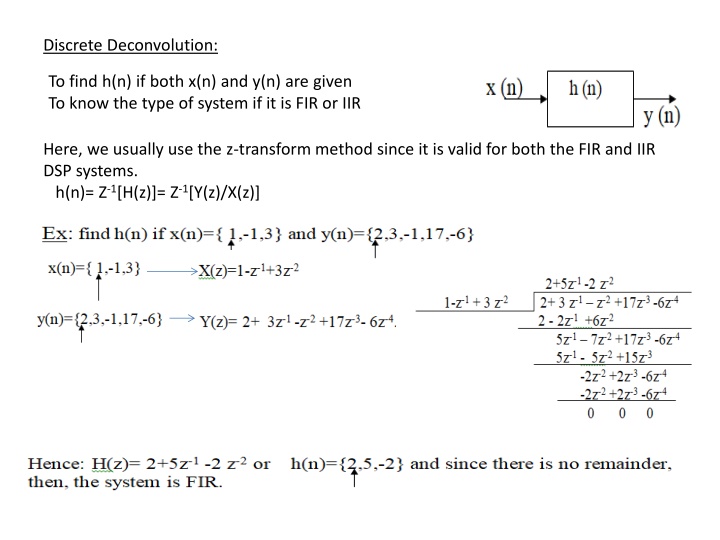
Discrete Deconvolution in DSP Systems
Explore the concept of discrete deconvolution in Digital Signal Processing (DSP) systems, learn how to determine FIR or IIR system types, implement deconvolution using z-transform, and analyze the spectral properties of discrete signals through Fourier series. Gain insights into finding h(n) given x(n) and y(n), along with examples and explanations for better understanding.
Download Presentation

Please find below an Image/Link to download the presentation.
The content on the website is provided AS IS for your information and personal use only. It may not be sold, licensed, or shared on other websites without obtaining consent from the author. If you encounter any issues during the download, it is possible that the publisher has removed the file from their server.
You are allowed to download the files provided on this website for personal or commercial use, subject to the condition that they are used lawfully. All files are the property of their respective owners.
The content on the website is provided AS IS for your information and personal use only. It may not be sold, licensed, or shared on other websites without obtaining consent from the author.
E N D
Presentation Transcript
Discrete Deconvolution: To find h(n) if both x(n) and y(n) are given To know the type of system if it is FIR or IIR Here, we usually use the z-transform method since it is valid for both the FIR and IIR DSP systems. h(n)= Z-1[H(z)]= Z-1[Y(z)/X(z)]
Ex: Find h(n) if x(n)=u(n) and y(n)=2u(n)-(0.5)n u(n). Solution: X(z)=z/(z-1) and Y(z)= [2z/(z-1)] [z/(z-0.5)] Hence h(n)=(0.5)n u(n).
DSP system Implementations Here h(n) has finite no of elements: Y (Z)= h(0) X(Z) + h(1) X(Z) + h(2) X(Z) + ..h(m) X(Z)
b)-IIR system: For IIR system having m-zeros and r-poles, y(n)=ao x(n)+a1 x(n-1)+a2 x(n-2)+ .+am x(n-m)- b1 y(n-1)- b2 y(n-2)- .- bry(n-r)
Spectral Analysis of Discrete Signals: a-periodic discrete signals: If x(n) is a periodic signal having a period of N samples, i.e. x(n) is repeated every N samples, then the frequency content of x(n) (spectral analysis) is obtained using discrete Fourier series (DFS), = 0 n N 2 n k 1 1 N j = ( ) ( ) X k x n e N N- 1 k 0 Where: n is the time index k is the frequency index 2 n k 1 N j = k = ( ) ( ) x n X k e N The inverse DFS is given by: N- 1 n 0 0
Ex: Find the DFS of the signals x(n) if x(n) is periodic with period N=4 samples and is defined for full period by: x(n)={2,-1,3,-3}. 2 n k 1 N 1 N j = n = ( ) ( ) X k x n e N 0 2 ) 0 ( n + + + + 3 1 ) 0 ( x ) 1 ( x ) 2 ( x ) 3 ( x 2 1 3 3 1 j = = = = ) 0 ( X ( ) x n e 4 =dc value 4 4 4 4 = 0 n 2 ) 1 ( 3 n 3 1 1 j j j = j = + + + ) 1 ( X ( ) [ ) 0 ( x ) 1 ( x ) 2 ( x ) 3 ( x ] x n e e e e 4 2 2 4 4 = 0 n X(1)=0.25[2-1(-j)+3(-1)-3(j)] = 0.25(-1-2j) = -0.25-0.5j X(2)=9/4 and X(3)=-0.25+0.5j Note that X(3)=X*(1) (* conjugate)
b- aperiodic or random discrete signals: If x(n)={x(0), x(1),x(2), .x(N-1)} is the sampled signal from x(t), then the DFT of x(n) is given by:
Ex: Speech signal is sampled at 8000Hz. Find the min number of samples to the DFT analysis such that frequency analysis is done with a resolution of 20Hz. for 20 Hz resolution, then 20=fs/N=8000/N, then N=400 samples, i.e.: x(n)={x(0),x(1),x(2), .x(399)} and: 1 ) ( k X 2 n k 399 j = n = ( ) x n e 400 400 0 Number of complex multiplications = NXN = N2
Ex: Find the DFT of the sampled sequence representing a sampled pulse: x(n)={1,1,1,0,0,0}. E 2 n k 1 N 1 N j = n = ( ) ( ) X k x n e N 0
Fast Fourier Transform (FFT) This is a fast method to find the DFT 1) For FFT base-2 (radix-2), then N must be a power of 2, i.e. N=2r (4,8,16,32,64,128,256,512, ). If N 2r, then 0's are added to complete the sequence to the nearest 2r value. 2 n k 1 N j = n = ( ) ( ) X k x n e N 0 3) Separate the samples into N/2 even samples and N/2 odd samples 4) X(k)=G(k)+WNk * H(k) .(1) where G(k)=DFT of the even numbered samples (N/2 samples) H(k)=DFT of the odd numbered samples (N/2 samples). WNk is the twiddle factor = e-j2 k/N
DFT of 2-samples: Where the unity path gain is not marked. The 2-point (samples) DFT is called "Butterfly'' Number of complex multiplications in FFT= N log2N
Ex: Draw the signal flow graph of the 4-point FFT, then use to it to find the spectrum of the sequence x(n)={1,-1,2,3}. The even numbered samples are x(0) and x(2) The odd numbered samples are x(1) and x(3) c X(0)=G(0)+W40 H(0) X(1)=G(1)+W41 H(1) X(2)=G(2)+W42 H(2) since G(2)=G(0)and H(2)=H(0) where 2-point DFT has a period of 2 samples, then X(2)=G(0)+W42 H(0) X(3)=G(3)+W43 H(3) And again G(3)=G(1)and H(3)=H(1), then: X(3)=G(1)+W43 H(1) E=















